Vacationers Are Destroying Hawaii’s Coral Reefs, Study Suggests
Through hashtags and location tags on pictures taken and posted by tourists on social media, scientists have concluded that coral reefs in areas more visited by tourists significantly suffer.

Hawaii is exotic and magical and has a siren’s call to all who love to travel. This, unfortunately, is its downside. About 11,000,000 visitors traveled to Hawaii in 2019. This is a 5.4% increase from the previous year. And, when 2020 stats hit, we’ll see an even bigger increase as thousands of land lovers pushed their way to the islands when Hawaii was not yet in lockdown from the COVID pandemic. And all these vacationers have ended up hurting the coral reefs.
According to ABC, new research shows, visually, that where there are fewer tourists, there is less coral reef degradation. This information seems incredibly obvious, but the way Princeton researchers found this information is extremely interesting. They used social media. Instagram, to be exact.
Researchers combed through 250,000 geotagged photos between 2018 and 2022 and compared those images to flyover maps of live coral reefs. They then used AI to show what the coral looked like two meters, or 6.5 feet, under the water.
The lead researcher says he got the idea because one of the first things tourists do when they get to Hawaii is take pictures of the ocean and then post them on Instagram. They then geotag it to let all their friends know that yes, indeed, they are, in fact, in Hawaii. (Take that Sarah Jones! I don’t have to keep up with you!)
So, because of all these humblebrags on social media, researchers found that, indeed, tourists are killing Hawaiian coral reefs. The spots where tourists frequently flocked had more deterioration in live coral than more remote places.
Although most tourists stay near the shoreline, in Hawaii, many tourists take excursions out in the ocean for snorkeling and scuba diving. So, by using hashtags like #snorkeling or #scubadiving combined with the geotags, researchers could gather more info.
The coral reefs are harmed through unintentional (or intentional) human-to-coral contact and pollution, including sunblock and sunscreen in the water. Coral reefs are endangered worldwide including in Australia, where the Great Barrier Reef is. Corals are suffering from coral bleaching due to increased temperatures in the water.
Although places like Hawaii have harmful–yet natural–dangers like volcanos, only humans have the special ability to singlehandedly take down coral reefs. Coral reefs are important to biodiversity because they are homes to many fish and creatures. Coral reefs also protect the coasts.
One way tourists can help is by going to Hawaii, not just to snorkel and scuba, but to take part in eco-tourism. Through this practice, folks can see the reefs and help oversee them by interacting with an app to report especially injured parts of the coral reefs.
Coral reefs are extremely important to local cultures and the animals they have been coexisting with for hundreds of years. If tourists and vacationers simply do some research before they travel to a place with coral reefs, they can find out what they can do to help while they are there. By taking part in this type of travel, people can help instead of harm.











